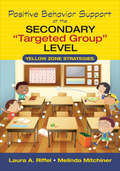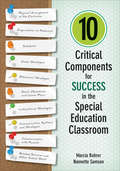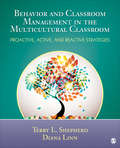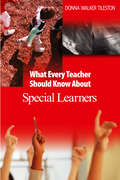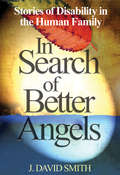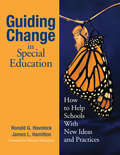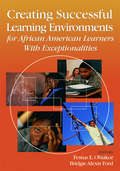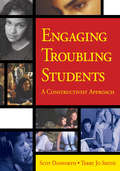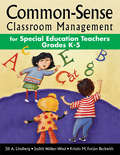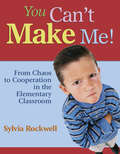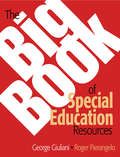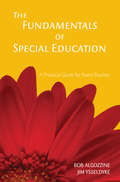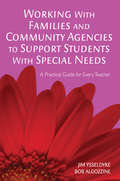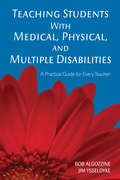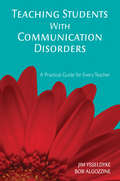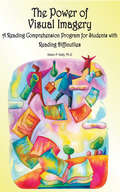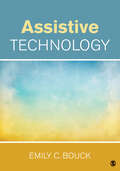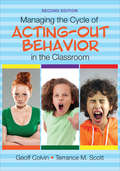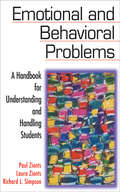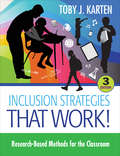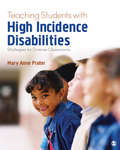- Table View
- List View
Positive Behavior Support at the Secondary "Targeted Group" Level: Yellow Zone Strategies
by Laura A. Riffel Melinda S. MitchinerSeal the gaps in student learning with targeted intervention This practical resource addresses the gap between school-wide disciplinary policies and interventions individually tailored to the most problematic students. Focusing on proactive strategies for small-group interventions, Laura Riffel’s research and techniques include: General strategies that can be applied at the individual level: Self-management, proximity control, peer mentoring and more Comprehensive action plans to anticipate any disciplinary issues A behavior rating sheet proven effective in improving student behavior “Funk Sway” For The Classroom: Using Feng Shui principles to create a classroom environment that enhances productivity, learning and creativity
10 Critical Components for Success in the Special Education Classroom: Gargiulo: Special Education In A Contemporary Society 5e + Rohrer: 10 Critical Components For Success In The Special Education Classroom
by Marcia W. Rohrer Nannette M. SamsonYour blueprint for building structure, consistency, and accountability year-round! This must-have guide provides special education teachers with a solid, workable action plan to manage the classroom and ensure student success. Learn instructional strategies to: Support all students with special needs, including those with more severe disabilities Organize your classroom, materials, and staff and student schedules Plan and assess standards-based lessons, annual IEP’s, behavioral interventions, and more Foster parent communication and staff collaboration Packed with real-world examples, free tools to use and share, a list of resources and a helpful glossary, this dynamic resource will inspire you, develop your teacher toolbox, and ensure your students are on the path to achievement!
Behavior and Classroom Management in the Multicultural Classroom: Proactive, Active, and Reactive Strategies
by Terry L. Shepherd Diana LinnAddressing the increasing number of culturally and linguistically diverse students in today’s schools, Behavior and Classroom Management in the Multicultural Classroom, by Terry L. Shepherd and Diana Linn, provides general and special education teachers with the knowledge, skills, and strategies to make the proactive, active, and reactive interventions necessary to create a positive classroom environment in which all students can learn. Going beyond the traditional rules and hierarchy of consequences and reinforcements, the book demonstrates how to incorporate basic classroom management plans, functional behavioral analysis, functional behavioral assessments, and behavioral intervention plans into the development and implementation of response-to-intervention and school-wide positive behavior support programs. In every chapter, the authors use real world examples and case studies to explore how language and culture affect students’ responses to behavior and classroom management. Unique chapters cover social skills training and collaborating with families of diverse students.
What Every Teacher Should Know About Special Learners
by Donna E. TilestonThis resource will help you differentiate content for special learners by identifying special programs and the laws and regulations that govern those programs.
In Search of Better Angels: Stories of Disability in the Human Family
by J. David SmithThis resource is a testament to the value of people with disabilities and the enrichment that we can find with them.
Guiding Change in Special Education: How to Help Schools With New Ideas and Practices
by Dr Ronald G. Havelock James L. HamiltonThis practical, step-by-step guide illustrates and describes the seven stages of school change and provides explanations and advice for incorporating each stage into your change process.
Creating Successful Learning Environments for African American Learners With Exceptionalities
by Dr Festus E. Obiakor Dr Bridgie Alexis FordIn this groundbreaking book, more than 25 leading scholars and practitioners provide concrete solutions for maximizing African American students' achievement.
Engaging Troubling Students: A Constructivist Approach
by Scot Danforth Terry Jo SmithFilled with rich narrative and designed for educators working with troubling students each day, this insightful, practical guide leads you in developing helpful, trusting student-teacher relationships.
Common-Sense Classroom Management for Special Education Teachers, Grades K-5
by Jill A. Lindberg Judith K. Walker-Wied Kristin M. BeckwithThis practical guide gives teachers simple strategies for organizing their classrooms and pacing their day to ensure that learners with special needs experience success.
You Can't Make Me!: From Chaos to Cooperation in the Elementary Classroom
by Sylvia RockwellOffering effective methods for teaching appropriate behavior to students who are defiant and disruptive, this book includes real-life teaching anecdotes, research-based strategies, and a unique parent supplement.
The Big Book of Special Education Resources
by George A. Giuliani Roger PierangeloSave time and frustration with this definitive special education resource to locate specialized clearinghouses and disability organizations, toll-free numbers, publications, state-specific entities, and more.
The Fundamentals of Special Education: A Practical Guide for Every Teacher
by Bob Algozzine Dr James E. YsseldykeThis guide highlights major concepts in special education—from disability categories, identification issues, and IEPs to appropriate learning environments and the roles general and special educators play.
Working With Families and Community Agencies to Support Students With Special Needs: A Practical Guide for Every Teacher
by Dr James E. Ysseldyke Bob AlgozzineTeachers will find practical guidelines for collaborating with families, applying early childhood intervention, using transition services, involving community agencies and businesses, and identifying post-high school options.
Teaching Students With Medical, Physical, and Multiple Disabilities: A Practical Guide for Every Teacher
by Bob Algozzine Dr James E. YsseldykeLearn about assistive technologies, helpful adjustments to school and classroom environments, and effective instructional modifications specifically designed to support students with medical, physical, and multiple disabilities.
Teaching Students With Communication Disorders: A Practical Guide for Every Teacher
by Dr James E. Ysseldyke Bob AlgozzineFocusing on teaching students with communication disorders, the authors offer practical teaching strategies and provide brief definitions, indicators, and behaviors associated with speech and language disorders.
The Power of Visual Imagery: A Reading Comprehension Program for Students with Reading Difficulties
by Karen Patricia KellyFormerly published by Peytral PublicationsThis user-friendly resource provides the theory for improving students' reading skills through visual imagery, plus actual lesson plans to use independently or alongside your language arts program.
Assistive Technology: Gargiulo: Special Education In Contemporary Society 5e + Bouck: Assistive Technology
by Emily C. BouckSuccinct, yet comprehensive, Assistive Technology is designed to help educators better understand assistive technology and how it can support students with disabilities from early childhood through transition into adulthood. This practical book considers the purpose of technology and the support it can provide rather than a student’s disability categorization. Grounded in research and filled with engaging case studies and activities, author Emily C. Bouck offers an unbiased depiction of the advantages and limitations of technology. Readers are exposed to a full range of assistive technology including up-to-date coverage of low- and high-technology, as well as free and for-purchase options that can be used to support students with disabilities.
Assistive Technology: Gargiulo: Special Education In Contemporary Society 5e + Bouck: Assistive Technology
by Emily C. BouckSuccinct, yet comprehensive, Assistive Technology is designed to help educators better understand assistive technology and how it can support students with disabilities from early childhood through transition into adulthood. This practical book considers the purpose of technology and the support it can provide rather than a student’s disability categorization. Grounded in research and filled with engaging case studies and activities, author Emily C. Bouck offers an unbiased depiction of the advantages and limitations of technology. Readers are exposed to a full range of assistive technology including up-to-date coverage of low- and high-technology, as well as free and for-purchase options that can be used to support students with disabilities.
Managing the Cycle of Acting-Out Behavior in the Classroom
by Terrance M. Scott Geoffrey T. ColvinMinimize problem behavior and maximize student success! Acting-out behavior by students manifests in ways that make classroom management and teaching very challenging. Building on a model using seven phases of acting-out behavior presented in the first edition, the newly updated edition draws on new research in applied behavior analysis, sound instructional principles, and functional behavior assessment to deliver a clear roadmap for educators to design interventions in a clear, systematic, and achievable matter. Features include: Managing each phase of the acting-out cycle—from structuring the classroom, to handling escalated behavior, to recovery Case studies that distill concrete action steps from the book’s concepts Checklists, tools, resources, and templates for applying the book’s principles to any classroom
Positive Behavior Support at the Secondary "Targeted Group" Level: Yellow Zone Strategies
by Laura A. Riffel Melinda S. MitchinerSeal the gaps in student learning with targeted intervention This practical resource addresses the gap between school-wide disciplinary policies and interventions individually tailored to the most problematic students. Focusing on proactive strategies for small-group interventions, Laura Riffel’s research and techniques include: General strategies that can be applied at the individual level: Self-management, proximity control, peer mentoring and more Comprehensive action plans to anticipate any disciplinary issues A behavior rating sheet proven effective in improving student behavior “Funk Sway” For The Classroom: Using Feng Shui principles to create a classroom environment that enhances productivity, learning and creativity
Emotional and Behavioral Problems: A Handbook for Understanding and Handling Students
by Richard L. Simpson Paul Zionts Laura T. ZiontsThe authors take a complex, under-discussed topic and give teachers and administrators useful, basic guidelines they can put to use quickly in understanding, identifying, and helping this special group of students.
Inclusion Strategies That Work!: Research-Based Methods for the Classroom
by Toby J. KartenThe go-to book for including ALL learners in educational success! Teaching students with diverse needs require educators to employ empathy, responsiveness, and patience. This book has long been the indispensable resource for K-12 teachers as they confidently form lesson plans and strategies for inclusion. In this new edition, Toby J. Karten’s data-driven methods are updated with the latest research and policy developments. The book’s content includes: Updated information on ADA, IDEA, writing IEPs, transitional services, classifications, RTI, metacognitive strategies, and links to the Common Core Tips for working with families and making them an integral part of the inclusive team An overview of special education legislative terminology Interactive online forms for planning, documentation, and collaboration
Inclusion Strategies That Work!: Research-Based Methods for the Classroom
by Toby J. KartenThe go-to book for including ALL learners in educational success! Teaching students with diverse needs require educators to employ empathy, responsiveness, and patience. This book has long been the indispensable resource for K-12 teachers as they confidently form lesson plans and strategies for inclusion. In this new edition, Toby J. Karten’s data-driven methods are updated with the latest research and policy developments. The book’s content includes: Updated information on ADA, IDEA, writing IEPs, transitional services, classifications, RTI, metacognitive strategies, and links to the Common Core Tips for working with families and making them an integral part of the inclusive team An overview of special education legislative terminology Interactive online forms for planning, documentation, and collaboration
Teaching Students With High-Incidence Disabilities: Strategies for Diverse Classrooms
by Mary Anne PraterTo ensure that all students receive quality instruction, Teaching Students with High-Incidence Disabilities prepares preservice teachers to teach students with learning disabilities, emotional behavioral disorders, intellectual disabilities, attention deficit hyperactivity, and high functioning autism. It also serves as a reference for those who have already received formal preparation in how to teach special needs students. Focusing on research-based instructional strategies, Mary Anne Prater gives explicit instructions and includes models throughout in the form of scripted lesson plans. The book also has a broad emphasis on diversity, with a section in each chapter devoted to exploring how instructional strategies can be modified to accommodate diverse exceptional students. Real-world classrooms are brought into focus using teacher tips, embedded case studies, and technology spotlights to enhance student learning.
Teaching Students With High-Incidence Disabilities: Strategies for Diverse Classrooms
by Mary Anne PraterTo ensure that all students receive quality instruction, Teaching Students with High-Incidence Disabilities prepares preservice teachers to teach students with learning disabilities, emotional behavioral disorders, intellectual disabilities, attention deficit hyperactivity, and high functioning autism. It also serves as a reference for those who have already received formal preparation in how to teach special needs students. Focusing on research-based instructional strategies, Mary Anne Prater gives explicit instructions and includes models throughout in the form of scripted lesson plans. The book also has a broad emphasis on diversity, with a section in each chapter devoted to exploring how instructional strategies can be modified to accommodate diverse exceptional students. Real-world classrooms are brought into focus using teacher tips, embedded case studies, and technology spotlights to enhance student learning.
